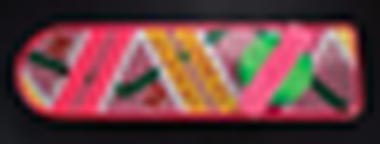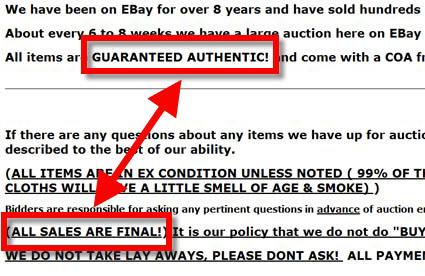I’ve noticed a number of trends on the rise of late, in the marketing and sale of original movie and television props and costumes in the marketplace, that are to the detriment of consumer hobbyists. From “Payment Before Provenance” to “COA Guarantees” paired with “All Sales Final” policies, I sometimes wonder if we are losing collectors faster than they are being cultivated, given the overall risks and omnipresent “buyer beware” atmosphere in which we collect. Coupled with eBay’s continuing policy changes toward “anonymizing” transactions, given the legacy of eBay being ground zero for new entrants to the hobby, buying truly authentic movie memorabilia with confidence has become more and more problematic and challenging.
One of the first editorials published in April 2007 – The Red Flags of Authenticity – covered a number of seller tactics that I felt should serve as a warning to collectors in navigating the marketplace in the search of original props. This article makes note of a handful of those which seem to be quite prominent.
Payment Before Provenance
One trend that seems to be on the rise of late, which is in my opinion contrary to the interests of consumer/hobbyists, is the practice of keeping sources, provenance, and/or chain of ownership a secret in the marketing of an original prop or costume for sale – to be revealed to the buyer only following agreement to buy and/or submission of payment. In essence, prospective buyers are expected to buy “on faith”.
As an example, this was seen with the Superman “Krypton” blanket listed recently on eBay by Daniel Green as “fearlessgreen” and subsequently “walrus25”:
While this is often the “rule” with sketchy and almost certain fraudulent pieces sold on eBay, it is not exclusive to unscrupulous eBay sellers, and even is employed by reputable dealers and auctions houses, who frequently shield the identity of sources and consignors.
In basic function, it indicates that the seller has determined on the buyer’s behalf what is authentic, which is ludicrous. But we see it again and again at all levels within the hobby.
The most interesting implementations and citations are those that reference prior owners and/or issuers of COAs as “well known” and “reputable”. If they are so public and revered, and the piece is as described, authentic, and of clear title, what is the purpose of the anonymity?
This trend toward a complete lack of transparency is both worrying and insulting to discerning collector, and dismisses the critical fact that provenance is value. If authenticity cannot be established, true market value should correspond accordingly. Provenance does not need a salesman or confidant, but should stand on its own for evaluation and appropriate scrutiny.
“Guaranteed Authentic” & “All Sales Final!”
This trend is one that always astonishes me, in that the two elements to the deal that are stressed so prominently are completely and entirely contradictory.
If all sales are final, in what manner could a “guarantee” be enforced?
Below is an example from the stonark/*stoneark* eBay “ME” page:
See: Market Watch | stonark / *stoneark* (Corner Collectibles)
“Contact Me For Details”
If someone is going to go through the trouble of listing something publicly for sale, why is it that everything one would want to know a secret and left unstated?
If the seller is willing to discuss with complete strangers privately, what is the purpose of not just listing the same information for everyone?
Is not public disclosure more valuable, since it is “on the record”, while private conversations are prone to “he said, she said” conflicts and disputes?
This is a trend that has carried over even to The Movie Prop Forum, with sellers announcing sales in which the actual item itself is not even named, let alone is a description, details of provenance, a photo, or a price articulated. What is a hobbyist to make of such practices?
Poor Photography in the Digital Age
There is simply no excuse for the use of poor and/or limited photos in the sale of original props. At this point, when I encounter poor photography in showcasing an original prop, my first question is to wonder if it was done so intentionally in order to hinder close examination of the offering.
Digital photography has become ubiquitous and extremely inexpensive. A VGA-quality camera can be purchased for under $20. Most mobile phones today come with digital cameras built in. A quality 8 megapixel camera can be purchased for well under $100. A 2GB SD card can be had for under $10.
So why do we still see photos in auctions at 400×260 resolution in which you can make out no detail whatsoever, between the low resolution, poor lighting, and blur? And why only one photo?
Hobby Trends and the Real World
In reviewing these trends, it is difficult to imagine them employed in other high end, respectable pursuits. Collectively, many of these activites truly do cast a shadow of illicitness over the hobby. My view is that the only way to correct this behavior is to acknowledge it, talk a bout it, challenge it, and certainly not reward those who practice it.
Jason De Bord



